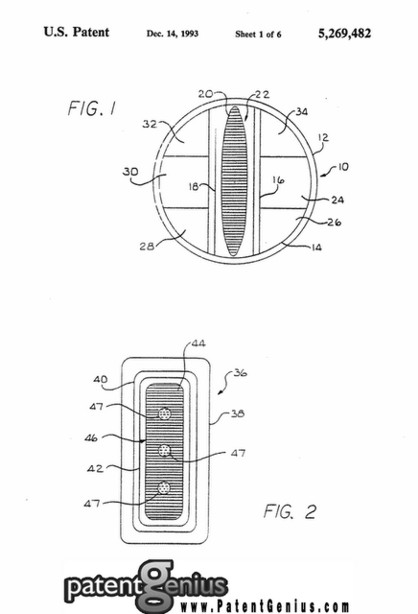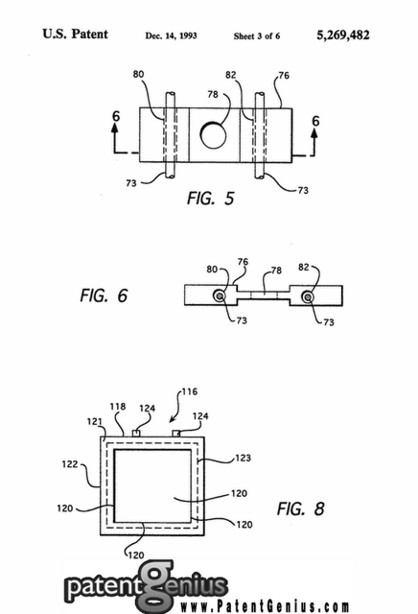



James F King Jr. MAGNETOHYDRODYNAMIC PROPULSION APPARATUS U.S.A patent # 3,322,374 1964
The present invention relates in general to craft propelled by magnetohydrodynamic effects and methods of propulsion and control thereof, and more particularly to heavier-than-air craft which are propelled by interaction of magnetic fields upon electrically conductive fluids such as plasma, surrounding the craft.
The technological field of magnetohydrodynamics, fThe technological field of magnetohydrodynamics, frequently referred to as MHD, is concerned with the study of dynamic effects of magnetic fields upon electrically conducting fluids, a prime example of which is plasma. The term "plasma," has been variously defined as a space charge neutralized ion cloud containing substantially equal numbers of positive ions and negative electrons, or any mixture of particles, some of which are charged, whose spatial dimension exceeds the Debye length and where the percentage of the mixture that is ionized contains an approximately equal number of positive and negative particles so that the overall aggregate is electrically neutral. As used in the present discussion, the term "plasma" is intended to described a gas or electrolyte which in addition to meeting the criteria just given is in such a state of ionization that it becomes conductive enough, to be affected by magnetic fields. That is to say, such an electrically conductive fluid medium containing charged particles is sufficiently conductive so that electric currents in the nature of eddy currents may be induced in the fluid medium by magnetic fields by the phenomena known as "mutual induction." An object of the present invention is the provision of a novel method and apparatus for propulsion of craft which relies upon interaction of magnetic fields produced by electrical currents in conductors on the craft with a surrounding electrically conductive environment or medium to produce reaction thrust. Another object of the present invention is the provision of a novel propulsion method and apparatus for heavier-than-air craft surrounded by a plasma or ionized field produced by the craft. Another object of the present invention is the provision of a heavier-than-air craft having self-contained means for generating an ionized or plasma field in air surrounding the craft and means for generating a polyphase excited moving magnetic field of such character that currents are induced in the surrounding ionized or plasma field which constitutes a mobile fluid conductor and the conductor medium is propelled by the moving magnetic fields to produce reactive thrust for propelling the craft. Yet another object of the present invention is the provision of propulsion apparatus for a craft of the character described in the preceding paragraph arranged in such a way as to permit direction control and impart inherent stability to the craft similar to that attained with dihedral wing arrangements. Other objects, advantages and capabilities of the invention will become apparent from the ensuing detailed description and accompanying drawings. Heretofore, arrangements have been disclosed for propulsion of craft by establishing high electrical D.C. potentials between spaced conductors or electrodes and thereby generating ions or charged particles which are electrically attracted in a selected direction and through collision with air molecules create a propulsive force. requently referred to as MHD, is concerned with the study of dynamic effects of magnetic fields upon electrically conducting fluids, a prime example of which is plasma. The term "plasma," has been variously defined as a space charge neutralized ion cloud containing substantially equal numbers of positive ions and negative electrons, or any mixture of particles, some of which are charged, whose spatial dimension exceeds the Debye length and where the percentage of the mixture that is ionized contains an approximately equal number of positive and negative particles so that the overall aggregate is electrically neutral. As used in the present discussion, the term "plasma" is intended to described a gas or electrolyte which in addition to meeting the criteria just given is in such a state of ionization that it becomes conductive enough, to be affected by magnetic fields. That is to say, such an electrically conductive fluid medium containing charged particles is sufficiently conductive so that electric currents in the nature of eddy currents may be induced in the fluid medium by magnetic fields by the phenomena known as "mutual induction." An object of the present invention is the provision of a novel method and apparatus for propulsion of craft which relies upon interaction of magnetic fields produced by electrical currents in conductors on the craft with a surrounding electrically conductive environment or medium to produce reaction thrust. Another object of the present invention is the provision of a novel propulsion method and apparatus for heavier-than-air craft surrounded by a plasma or ionized field produced by the craft. Another object of the present invention is the provision of a heavier-than-air craft having self-contained means for generating an ionized or plasma field in air surrounding the craft and means for generating a polyphase excited moving magnetic field of such character that currents are induced in the surrounding ionized or plasma field which constitutes a mobile fluid conductor and the conductor medium is propelled by the moving magnetic fields to produce reactive thrust for propelling the craft. Yet another object of the present invention is the provision of propulsion apparatus for a craft of the character described in the preceding paragraph arranged in such a way as to permit direction control and impart inherent stability to the craft similar to that attained with dihedral wing arrangements. Other objects, advantages and capabilities of the invention will become apparent from the ensuing detailed description and accompanying drawings. Heretofore, arrangements have been disclosed for propulsion of craft by establishing high electrical D.C. potentials between spaced conductors or electrodes and thereby generating ions or charged particles which are electrically attracted in a selected direction and through collision with air molecules create a propulsive force.
Dipolar Force Field Propulsion System. James E. Cox patent # 4,663,932 May 12, 1987
From U.S.A. patent 4,663,932; A dipolar force field propulsion system having a alternating electric field source for producing electromotive lines of force which extend in a first direction and which vary at a selected frequency and having an electric field strength of a predetermined magnitude, a source of an alternating magnetic field having magnetic lines of force which extend in a second direction which is at a predetermined angle to the first direction of the electromotive lines of force and which cross and intercept the electromotive line of force at a predetermined location defining a force field region and wherein the frequency of the alternating magnetic field substantially equal to the frequency of the alternating electric field and at a selected in phase angle therewith and wherein the magnetic field has a flux density which when multiplied times the selected frequency is less than a known characteristic field ionization potential limit; a source of neutral particles of matter having a selected dipole characteristic and having a known characteristic field ionization potential limit which is greater than the magnitude of the electric field and wherein the dipoles of the particles of matter are capable of being driven into cyclic rotation at the selected frequency by the electric field to produce a reactive thrust, a vaporizing stage which vaporizes said particles of matter into a gaseous state at a selected temperature, and a transporting system for transporting the vaporized particles of matter into the force field defined by the crossing electromotive lines of force and the magnetic lines of force. Inventor: Cox; James E. (Los Angeles, CA) 1982.
Protective Enclosure Apparatus for Magnetic Propulsion Space Vehicle.Ernest J. Shearing patent # 5,269,482 December 14, 1993
Finally any of these drive systems would be dangerous to the crew of the ship, due to the high acceleration possible, and because of the power of the magnetic fields used. The engine areas would of course be shielded to help concentrate the fields and to protect the passengers from EM radiation. Gravity and acceleration must also be countered to protect the crew. That is the purpose of this invention.
This is accomplished by means of a superconductive Dewar Vessel. This vessel has a chamber made of superconductive material, surrounded by suspended magnets of the same material. The system has accelerometers for each of the X, Y, and Z-axis. When gravity or acceleration changes are detected, the system sets up an opposing field to cancel out those changes. This invention makes these propulsion systems safer and more capable because the crew is protected from the inherent dangers of fast direction changes. This makes them more maneuverable, as I have seen first hand. If the crew were subjected to the forces of acceleration possible with these engines, we would have a hard time scraping them from the walls of their ships.
So it appears we now have all of the necessary components available to be on par with "other space-faring worlds". All With human engineered technology! I'm certain we will find that the solid-state electromagnetic spacecraft is the preferred mode of travel in the galaxy. Bearing this in mind, why should we waste our time and our resources on dangerous chemical rocket systems, costing billions of dollars, and not paying off in the same way as efficient, clean, solid state propulsion systems? Since the cost involved with a solid-state system is in the construction and not in their operation, they are the most practical choice for a continued use space vehicle configuration. If you have an engineering background in high potential electromagnetics you will find the inclusion of the complete patent disclosure documents very helpful. I recommend that even the novice reader at least read the description of the preferred embodiment, section of each document. I further recommend that the reader review the entire patent collection for a complete understanding of the relevant science, and math behind each invention. The purpose of my breakdown of the information is to help the novice to see the potential of these systems. I think the advanced reader will find interesting new engineering possibilities with these components plugged into you own designs.
Electromagnetic Energy Propulsion Engine *James R. Taylor, patent # 5,197,279
The Taylor engine uses a very different means to propel the craft. This drive system is most suitable for use as a deep space drive, because it requires no gas field or solid propellant. This drive system only requires that it remain at a superconductive temperature, and has high-density electric power supply available for producing the required magnetic field. This engine is very much like the impulse engines from Star Trek.
It works by shearing off electromagnetic bubbles at very high frequency. This creates ripples on the fabric of space-time on which to ride. All this is accomplished by producing two opposing high-density electromagnetic fields in opposition to one another, then Canceling out one field, and at the same time shearing off the opposing field with a torriodial wound coil. Then the computer control introduces an eddy current into the now turned off field coil to prevent a back EMF from forming. All of this is a little confusing for someone with no engineering background in the field. It suffices to say that what we have here is a solid-state device very similar to what we might expect to find in a UFO, or as I stated earlier A star trek impulse engine.
"Scotty, tell me you have the impulse engines on line"
"Aye captain we have impulse power" "Take us ahead then Mr.Scott Full Impulse"
The inventor estimates that with existing or anticipated superconductors, and with existing or anticipated power supplies, that the speed possible, with engines of this design, would be in the order of 29,900kps. This is roughly 10% of Light Speed. Not too shabby when compared to rockets. This system only requires a 10kev electric cell, which is available right now from General Electric. If the craft uses the new high temp superconductor materials available today it would not even require liquid Helium which is expensive and difficult to maintain in storage. Cheap and plentiful liquid Nitrogen could be used. It’s easy to cool so it can be recycled and used again and again. The Taylor Drive doesn't have the radar invisibility of the Dipolar Force Field system so a combination of these 2 systems could be deployed where their advantages are best exploited. The Dipolar system, in or near atmosphere and close orbit then, switching to the Taylor Drive for between world travels. I will discuss this in greater detail later in the book. The only technical problem we must overcome with these new high temperature superconductors is that of brittleness and magneto-restrictive forces breaking down the field drive coils. Once this is solved we can use the high temperature superconductive elements without making major design changes.
Electrokenetic Transducer T. Townsend Brown Patent #2,949,550

Thomas Townsend Brown did the earliest work on electromotive force, for use in a drive system. Townsend Brown was a physicist, who discovered, that a transducer would lose weight when charged with a significant direct current. He patented a number of inventions based on his discovery. One of the drawings for his first invention is shown below this drawing shows his Electrokenetic Transducer tethered to a center hub that provides power to the transducer. One can easily imagine what this device could do if the power supply were shrunken in size and placed within the disk. If charge could be controlled, and moved about the disk, the disk could change direction as quickly as flipping a switch.
While studying the magnetic properties of high voltage capacitors, Thomas Townsend Brown noticed that when sufficient charge is applied to a transducer, the transducer would lose weight in proportion to the charge.
He theorized that if the overall weight of the capacitor materials could be reduced, without reducing the K value of the capacitor, (that is how much charge it will hold without arcing through) He could get that sucker to fly with a sufficient charge.
Biefeld-Brown Effect: http://www.zamandayolculuk.com/cetinbal/biefeldbrowneffect.htm


According to popmech.ru the photos presented are from the private collection of an old Russian Air Force retiree, who eye witnessed the flying saucers made for the Russian army in the 1950s and even had a chance to make these photos. Their AF squad had a task to compete those machines in order to test their characteristics in air fight at the Russian Air Force base on Spitzbergen or Slalbard island, north of Norway.

The present invention relates in general to craft propelled by magnetohydrodynamic effects and methods of propulsion and control thereof, and more particularly to heavier-than-air craft which are propelled by interaction of magnetic fields upon electrically conductive fluids such as plasma, surrounding the craft.

![]()
![]()
UFO SPECS AND HAUNEBU TYPES
We bring you the full data specifications of the flying discs.





OUR SPONSORS & PARTNERS:
WE ARE PROUD RESEARCHERS OF:






PLEASE HELP US TO EXIST IN THE FUTURE!
























